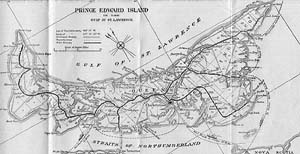








Being an island tends to promote insularity, and our province has a long history of resisting new transportation systems. There are quite a few similarities, for example, between the railway debate of the mid-nineteenth century and the recent flare-ups over the construction of a fixed link to the mainland. While both government initiatives had solid support, and were couched in promises of a better economic future, they also met with fierce and extremely vocal opposition from other segments of the Island population. Both the railway and the fixed link were perceived as threats to an 'Island way of life' where things unfold at a familiar pace, and everyday existence is free from hurry and traffic. It is amazing how little things change over the course of a hundred years.
By 1871,
the new Dominion of Canada had decided to embark on a
grand project of railroad construction, forging a link of
iron stretching from the Atlantic to the Pacific Ocean.
While Prince Edward Island had not joined Confederation
in 1867-- although it had played host to the first
conference-- the colony thought it would prosper if it
hitched its own railroad to the nationwide line. When the
new government under J.C. Pope took to the floor of the
legislature in 1871, a groundswell of support for railway
building was starting to build. The massive financial
commitment that such a project would require made many
skeptical, but its supporters assured them that the
long-term gains of having a railroad would far outweigh
the short-term pain. A railway, they insisted, would
gainfully employ Islanders, create a flourishing export
market, and bring an influx of American tourists to the
area .
.
The 1871 railway vote in the legislature came down to a final tie-breaker, and when Donald Cameron voted for construction, the die was cast. The Railway Bill was passed, and a boisterous pro-railway crowd carried Cameron on their shoulders through the streets of Charlottetown. The contract for the construction of the railway was awarded to Schreiber and Burpee. Mrs. W. F. C. Robinson, the wife of the Lieutenant Governor, turned the first sod on October 5 of that same year, and the road beds, narrow gauge tracks (3' 6" rather than the standard 4' 8"), and train stations for the new line began springing up all across the Island.
But the Island's full-steam ahead approach to
railway building would have benefitted from some sober
second thought. The government's main oversight was that
it failed to specify the length and precise route of the
railway. The contract stipulated a fixed cost per mile,
but set no actual limit on how much mileage the
contractors could build. The builders had free reign--
and even an incentive-- to wind the railroad around
obstacles like hills or streams, as they not only were
lowering their own cost but  actually
adding more money-earning miles to the route. The end
result was that, even though the Island is only 120 miles
long, its finished railway had 147 miles of track! The
Prince Edward Island railway became known for some of the
most crooked road beds in the world, with up to a third
of its total line comprised of curves.
actually
adding more money-earning miles to the route. The end
result was that, even though the Island is only 120 miles
long, its finished railway had 147 miles of track! The
Prince Edward Island railway became known for some of the
most crooked road beds in the world, with up to a third
of its total line comprised of curves.
But the winding track was not entirely the result of rolling topography. Because there were no exact details on where track would be laid, the building of the railway touched off a powderkeg of patronage and bribery. Of course, every community wanted the influx of money and business that the railway could provide, and local lobbyists were willing to pay top dollar to reroute the surveyed rail lines or to guarantee that they would receive a railway station. A representative from eastern P.E.I. admitted that he had been offered $1,000 if he would vote for the construction of a branch line to a certain town. In addition to putting more bends and branches in the track, this rampant influence-peddling contributed to the proliferation of rail stations on the Island, constructed at the rate of one every two-and-a-half miles!
By December 1872, it was obvious that the government had made fatal miscalculations in determining the cost of the railway venture. The debt load for the railway was approaching three and a quarter million dollars, an amount which would necessitate a crippling taxation rate. The controversy surrounding the building of the railway led to the dissolution of government, and in the ensuing election, Pope and his fellow statesmen were tossed out of office. Even so, the hands of the new legislature were tied by the terms of the railway contract. They had no choice but to continue building branch lines from Tignish to Souris, to the tune of $14,500 per mile. With these staggering costs mounting, the Island could no longer afford its anti-Confederation stance, and had to put its independence-- its only remaining asset-- on the auction block. When the colony re-entered negotiations with the Dominion of Canada, perhaps the most important condition on the table was the assumption of the massive railway debt. After traveling on the rollercoaster that was the Prince Edward Island Railway, the new province road into Confederation on July 1, 1873.
